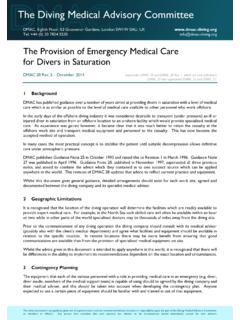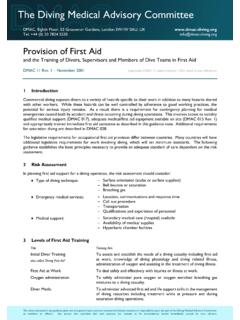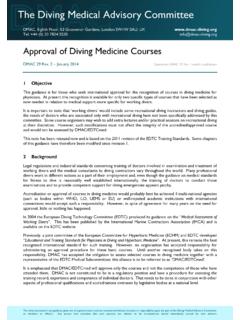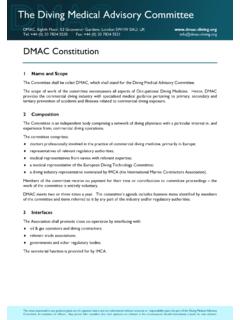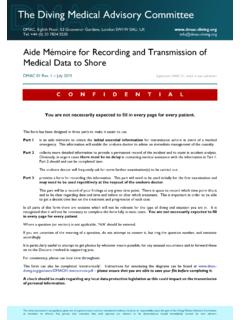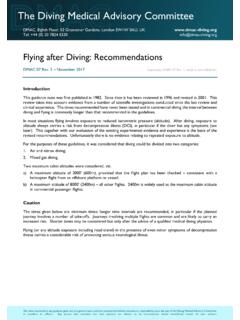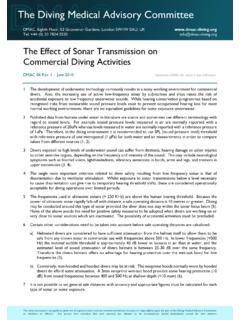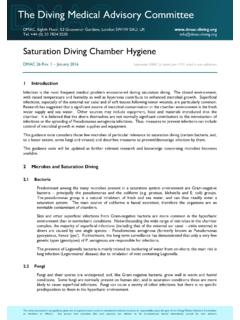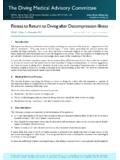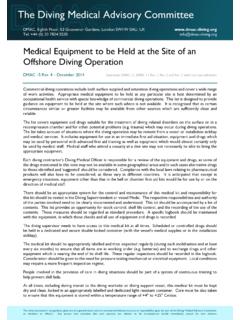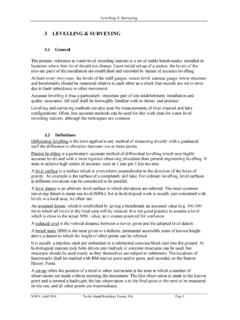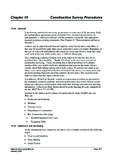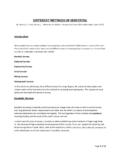Transcription of The Diving Medical Advisory Committee
1 The Diving Medical Advisory Committee DMAC, 52 Grosvenor Gardens, London SW1W 0AU, UK Tel: +44 (0) 20 7824 5520 The views expressed in any guidance given are of a general nature and are volunteered without recourse or responsibility upon the part of the Diving Medical Advisory Committee , its members or officers. Any person who considers that such opinions are relevant to his circumstances should immediately consult his own advisers. Safe Diving Distance from Seismic Surveying Operations DMAC 12 Rev. 1 July 2011 Supersedes DMAC 12 which is now withdrawn Background Guidance Note DMAC 012 was issued in 1979 after consideration of the knowledge concerning the effects of seismic operations on divers in the water at that time.
2 Over the last 30 years DMAC has discussed this guidance on a number of occasions and attempted to gain further knowledge from reports of diver/seismic operation interaction. Some of the few available reports have added to our knowledge. 1 Seismic airgun activity results in the transmission of acoustic waves through the water which the diver experiences as a noise analogous to a piling hammer. Multiple reflections of this acoustic wave from the sea surface, seabed and other structures may result in this sounding like a low frequency rumble. 2 The intensity of the sound experienced by the diver is principally dependent on the power of the seismic airgun array and the distance between the diver and the seismic airgun, but other factors may have important effects.
3 These factors include the water depth at which the seismic activity takes place, the presence of thermoclines (layering due to changes in temperature), the depth of the diver versus the depth of the thermocline, bottom conditions, salinity and the sea state. 3 Not all seismic surveys are the same ( ocean bottom cable surveys (OBC), streamer(s), vertical seismic profile surveys (VSP), site surveys, etc.) and there are differences in the types and purpose of source arrays used around the world, airguns, boomers, sparkers, etc. 4 The multiple factors involved make it difficult to determine a safe or tolerable distance, particularly in shallow water, without performing communication exercises between seismic and Diving operations. 5 The duration of a diver s exposure may limit tolerance.
4 Guidance 1 Where Diving and seismic activity will occur within a distance of 10 kilometres, a joint risk assessment should be conducted, between the operators involved and the seismic and Diving contractors in advance of any simultaneous operations. 2 Where possible, plans should be made to avoid overlapping seismic and Diving activities. Where this is not possible, the activities should be prioritised and a simultaneous operations (SIMOPS) plan developed. 3 The parties should perform a communication exercise or test at the start of simultaneous operations to determine the acceptable safe distance for the local conditions. Starting at a distance of 10 kilometres, the seismic source array will be gradually ramped up, and the seismic vessel gradually moved closer to the Diving operation, with constant communication between the Diving supervisor and the seismic party manager.
5 (Note: seismic source ramp ups are now the industry standard in all situations.) 4 The minimum safe distance, as determined from the testing outlined above, should not be compromised by either party. 5 There should be regular contact (at least daily) between the seismic vessel and Diving vessel so that both are aware of each other s work program for the day. Page 2 July 2011 DMAC 12 Rev. 1 6 Communications between the seismic vessel and the Diving vessel should be continuous where the operating distance is less than 5 kilometres. 7 Should any diver in the water suddenly experience discomfort, the seismic source should be turned off immediately if requested to do so. The SIMOPS plan should include contingency arrangements for this situation. 8 In adverse circumstances, , shallow water or in the presence of thermoclines, the tolerable distance may be increased based on risk assessment or the actual conditions that exist.
6 9 The health impact of exposure to noise in the underwater environment is difficult to assess. A diver s exposure should be terminated if the noise level is considered to exceed acceptable noise exposure levels, interferes with diver communications, induces discomfort or places the diver at risk in any other way.
